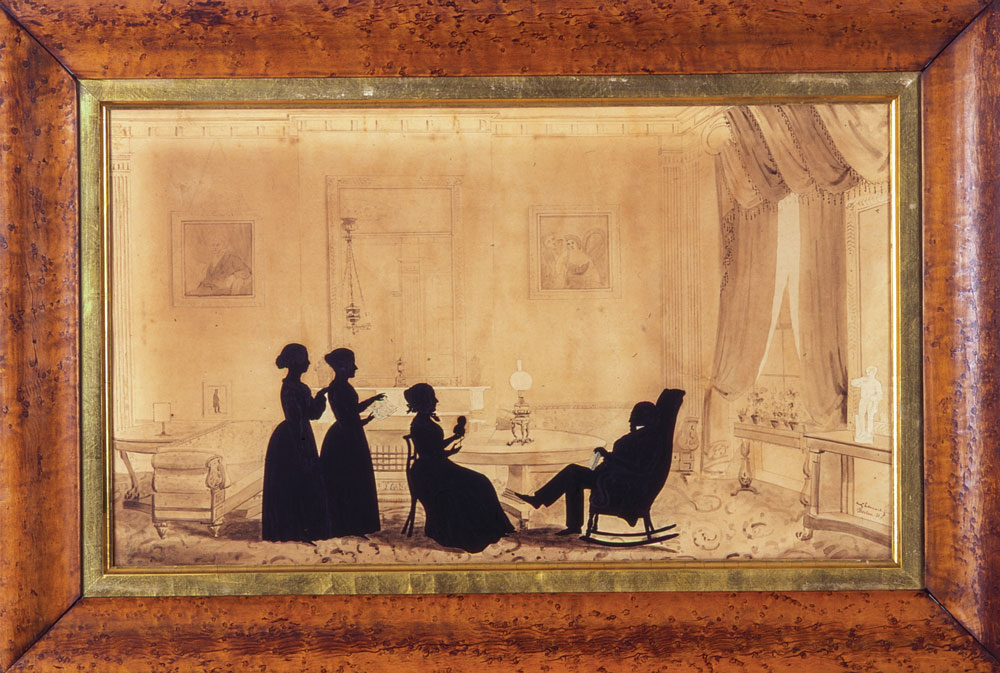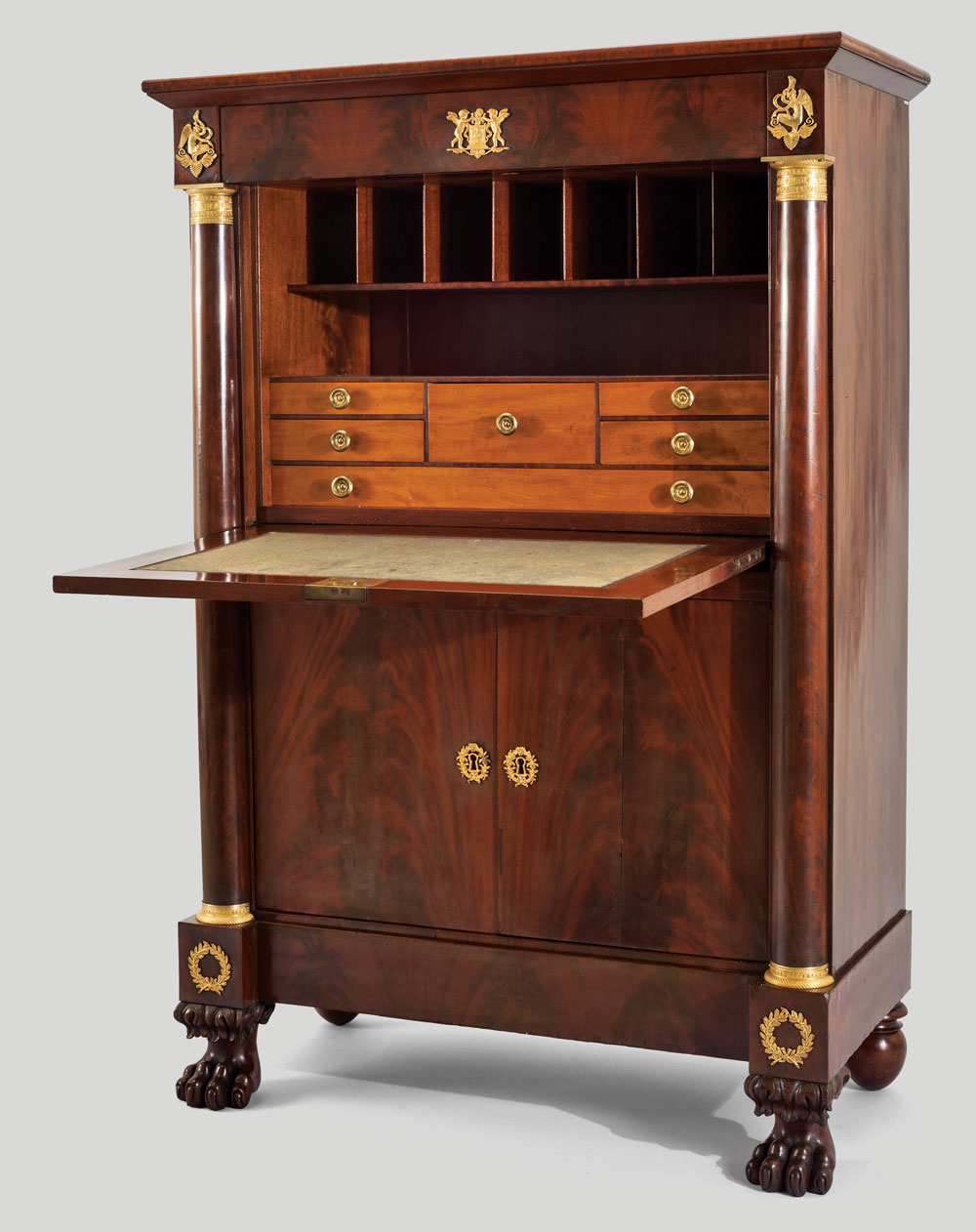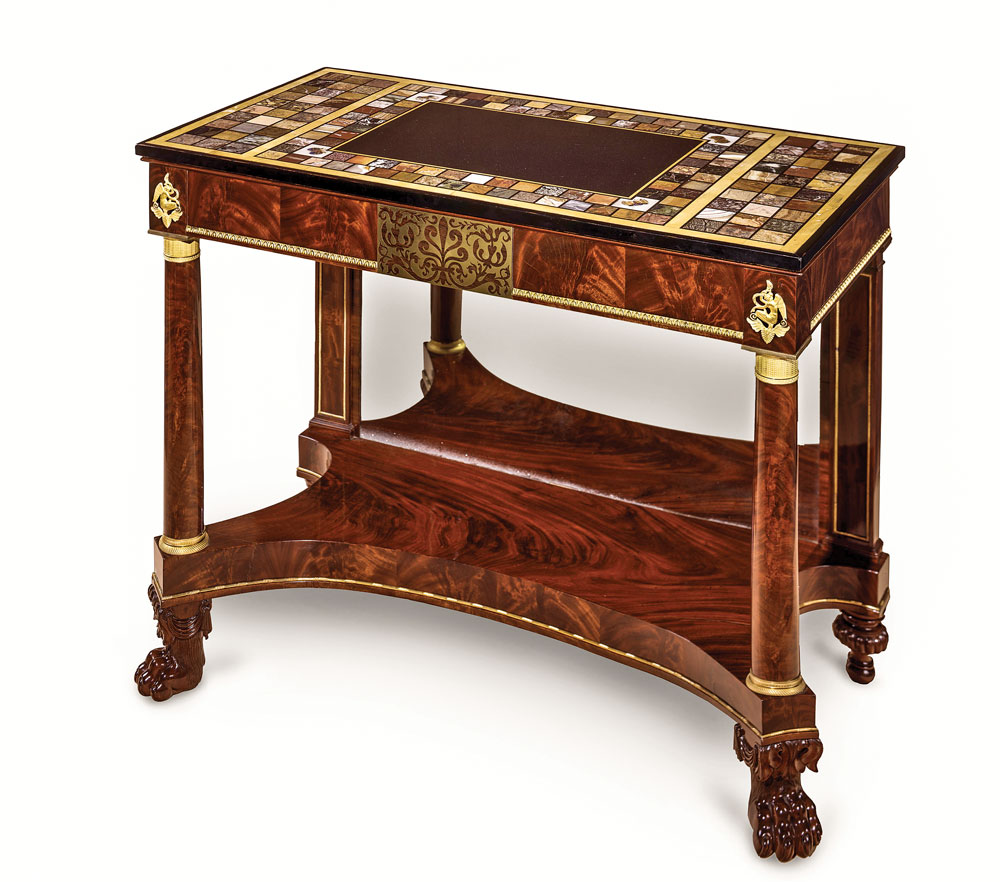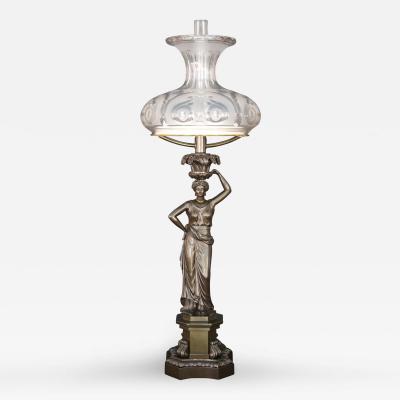Following the Trail of a "Lost" Secretary Bookcase
The Role of Family Ties and Serendipity
In 2008, Sotheby’s sold a half-plate daguerreotype of Boston merchant Samuel Appleton, probably taken shortly before his death in 1853, for an astonishing $409,000 (Fig. 1). Appleton was not photographed in a studio setting as was customary at the time, but seated in a room now thought to be one of the double parlors of his own house at 37 Beacon Street. Behind him are a marble mantel, presumably Italian-made, of the type favored by the city’s elite in the early nineteenth century, and a secretaire à abattant, probably made in Boston and referred to there as a French secretary. The mirror panels set in a false window behind the secretary reflect an arched paneled door and a pilaster that correspond to the features of the second Appleton parlor visible in the mirror over the fireplace in a group silhouette by Auguste Edouart (Fig. 2). The silhouette shows Samuel Appleton and his wife, Mary, along with her favorite niece and another young woman, in an elegantly outfitted room. The furnishings visible in the silhouette include a large round center table, a pair of sofas similar in design to an example now at Winterthur, and a pier table with carved paw feet. A portrait of Appleton by Gilbert Stuart Newton and a copy of Titian’s "Woman with a Mirror" hang on the wall. The large looking glasses with carved rosettes and foliate decoration are the type John Doggett made for many Bostonians.
Samuel Appleton (1766–1853) was one of Boston’s wealthiest citizens. Born on a farm in New Ipswich, New Hampshire, he tried his hand at driving cattle, homesteading in Maine, teaching school, and operating a country store before coming to Boston with little money to begin his career as a “merchant.” He encouraged his brother Nathan to join him and the two became very successful, culminating in their involvement in the burgeoning textile manufacturing business. Both were involved in civic affairs and known for their philanthropy. In 1823, Samuel wrote, “I promise, during the following year, to spend the whole of my entire income, either in frivolity, amusement, public utility or benevolence.” 1 He is best remembered for the latter since for most of his later years he spent more than half of his considerable income on charity.
Both Appleton brothers built elegant houses on Beacon Street and furnished them in the most up-to-date style. Nathan’s house at number 39 remains and many of its original furnishings have become touchstones in the study of Boston classical furniture.2 In contrast, Samuel Appleton’s house no longer stands and its furnishings have virtually disappeared. A year after his death, his widow sold the house at 37 Beacon Street, remodeled another house that she had inherited further down Beacon Street and moved there. What she took with her, sold, or gave away at that time is unknown. The Appletons had no children, so when Mary Appleton died in 1870, I originally surmised that she had left her estate to her favorite niece, Maria Goodwin, whom Samuel said had lived with the couple “as one of my family.”
I long thought that the story stopped there, but a series of serendipitous events led to an amazing discovery, almost in my own back yard. For many years, my wife and I had been intrigued with another Boston merchant by the name of David Hinckley. Shortly after the War of 1812, Hinckley built a large granite house, no longer standing, on Beacon Street, near the Appleton brothers’ houses. He died in 1825 and the inventory of his estate lists rooms lavishly furnished with silk draperies and matching upholstery, marble statues, center tables with mosaic tops, and elegant chandeliers. We never located any furnishings with a Hinckley provenance and often wondered where Hinckley’s portrait by Gilbert Stuart might be. Lawrence Park’s four-volume work on Stuart published in 1926 recorded that the portrait had descended to a family member whose last name was Bangs. Doing a little Internet research one day, I typed in the name “David Hinckley Bangs,” and was surprised to discover that an individual with that name lived in my same town, in fact, only two streets away from where my wife and I live.
I wrote to Mr. Bangs and asked if he knew the whereabouts of David Hinckley’s portrait or any of his furnishings. The day before I sent the letter, I had gone to Boston and done some probate research to determine if indeed Mary Appleton had left her estate to her favorite niece. She had not. Instead she had designated a nephew, Edward Bangs, to serve as executor and had left him all her real estate and possessions. I knew from Park’s book that David Hinckley’s granddaughter had married a man named Edward Bangs and also mentioned this coincidence in my letter.
Mr. Bangs replied that although he did not own the portrait, he did have miniatures of David Hinckley and his wife. Nothing else remained in the family as far as he knew. He also said that the Edward Bangs who married Hinckley’s granddaughter was his great-grandfather. He invited us to come and look at the miniatures, which we happily did. While we were there, he showed us two pieces of furniture he had inherited and he asked if we thought they might relate to David Hinckley. One was too late in date, but I was stunned when I got closer to the second piece, in the corner of the living room. Staring me in the face was what had to be the secretary in the daguerreotype of Samuel Appleton (Fig. 3). The visual clue? The ormolu mounts. The proof? Our host’s relation to Mary Appleton’s nephew and heir. (Further research revealed that Edward Bangs in fact first met his future wife, Hinckley’s granddaughter, while she was staying with Samuel and Mary Appleton.)
The secretary, now a gift to Historic New England, was probably commissioned soon after Appleton’s marriage in 1819 to Mary Lekain Gore, a widow twenty-three years younger. Examination by Robert Mussey and Clark Pearce has determined it was made by the firm of Isaac Vose and Joshua Coates, who also made furniture for Samuel’s brother, Nathan, at about the same time. Its discovery suggests the provenance of another piece attributed to that firm should be reconsidered: the pier table with its handsome specimen marble top in the Kaufman collection in the National Gallery in Washington (Fig. 4). Because that table was found in the house of Nathan Appleton’s daughter, Mrs. Greely Curtis, it was assumed she had inherited it from her father. But could it have belonged to Samuel instead and then given to his niece by Mary Appleton at some point as well? The curved shape of the base and the paw feet of the pier table depicted in the Edouart silhouette and, most significantly, the identical winged nymph mounts on Samuel’s secretary (Fig. 5) add credence to this conjecture. Perhaps one day another bit of serendipity will provide the answer.
-----
Richard C. Nylander is curator emeritus of Historic New England.
This article was originally published in the Winter 2016 issue of Antiques & Fine Art magazine, a fully digitized version of which is available on afamag.com. AFA is affiliated with Incollect.
2. They were first discussed by Page Talbot in The Magazine Antiques (May 1975). More recent research by Robert Mussey and Clark Pearce will be published in the forthcoming Boston Furniture, 1700–1900.




































